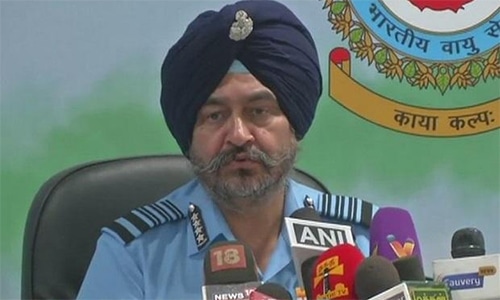'Indian Air Force not in a position to count casualties,' air chief marshal says on Balakot air strike

India's Air Chief Marshal Birender Singh Dhanoa on Monday placed the onus of announcing the number of 'casualties' that resulted from an airstrike in Pakistan's Balakot on the BJP government, saying that the Indian Air Force (IAF) "cannot count how many people died", NDTV reported.
"That statement will be made by the government," Dhanoa said in response to a question during a press conference in Coimbatore.
"Air force is not in a position to clarify how many people were inside... we do not count human casualties," he said. His statement comes a day after Bharatiya Janata Party (BJP) president Amit Shah claimed "more than 250 terrorists" were killed in the air strikes in Balakot on "training camps of the Jaish-e-Mohammed (JeM)".
Know more: Villagers near Balakot say nobody killed or injured by Indian aircraft
Last week, the Indian Air Force (IAF) violated Pakistani airspace and returned unsuccessful after the Pakistan Air Force (PAF) "immediately scrambled" its jets. According to Inter-Services Public Relations (ISPR), the Indian aircraft released their payload "in haste" as they returned.
There were no casualties from the incident, the military's media wing had clarified.
The air chief on Monday, however, insisted that the IAF had "hit the target".
"Otherwise why would [Pakistan] have responded? If we had dropped bombs in the jungle there would be no need to respond," he said, failing to acknowledge that India violated the undisputed territory of Pakistan to launch an attack on Pakistani soil.
Dhanoa also refused to comment further on what he described as an "ongoing operation", saying: "We won't comment on ongoing operations. A MiG-21 Bison is capable, upgraded, has a better weapon system, [and] better radar."
When asked about Indian pilot Abhinandan Varthaman — who was captured after his plane was downed and then released by Pakistan within two days — flying again, Dhanoa said if he gets fit immediately, he will fly a fighter jet. "We don't take chances with the medical fitness of a pilot," he added.
Pakistan had downed two Indian aircraft on Feb 27, at least one of which was a MiG-21 Bison. The loss had triggered Indian Prime Minister Narendra Modi to say the results of the dogfight would have been different if India had inducted Rafale fighter jets into its airforce; a comment seen as a veiled swipe at the MiG-21.
In a short press conference after the Balakot airstrike, India's Foreign Secretary VK Gokhale had claimed that the airstrike "had struck the biggest training camp of Jaish-e-Mohammad (JeM) in Balakot" and that "a large number of JeM terrorists were killed". However, he had not given figures or taken questions. Several Indian media outlets had nonetheless reported that more than 300 people were killed.
No mention of number of casualties was made when representatives of the three Indian armed services addressed the media on Thursday.
In response to a question, Air Vice-Marshal R.G.K. Kapoor had said it was premature to comment on the number of casualties and it was for the government to decide if it wanted to share the evidence.
The statements by Indian media and officials were called into question after pictures released by ISPR showed craters and fallen trees in a forest. Journalists who later visited the site reported that only an elderly man was injured from the explosions and no infrastructure was damaged.
People in India have also called into question the claim of hitting targets; among them was Former Indian cricketer-turned-politician Navjot Singh Sidhu who on Monday, via a tweet, asked: "300 terrorist dead, Yes or No? What was the purpose then? Were you uprooting terrorist or trees? Was it an election gimmick?"
'Vintage' equipment
In the aftermath of the air fight between the two rival countries, questions were raised regarding India's military equipment termed as "vintage" by a report in The New York Times on Sunday.
"While the challenges faced by the India’s armed forces are no secret, its loss of a plane last week to a country whose military is about half the size and receives a quarter of the funding was still telling," The New York Times said. It also pointed out that the United States had sold India arms worth $15 billion in a decade.
"If intense warfare broke out tomorrow, India could supply its troops with only 10 days of ammunition, according to government estimates. And 68 per cent of the army’s equipment is so old, it is officially considered 'vintage'," the report said.













































